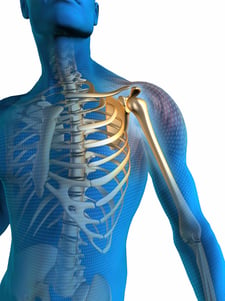The Mighty Rotator Cuff - Blog - Reeve Foundation
A couple of weeks back, I tore my left rotator cuff and it was no picnic at the seashore. It came on gradually, with no apparent cause, and of course I kept saying it was only a minor shoulder strain until the intermittent lightening sharp pain finally sent me to the orthopedist.
 I’m probably preaching to the choir here, but the rotator cuff is a significant part of wheelchair living and rotator cuff injuries are a clear and present danger, especially if you are over sixty, like some of us senior citizens. As Dr. Andrew Weiss, my own savvy ortho man, explains, being a paraplegic and over 60 is a double whammy. One or both could do you in and your chances of getting some kind of rotator cuff injury are excellent. Congratulations.
I’m probably preaching to the choir here, but the rotator cuff is a significant part of wheelchair living and rotator cuff injuries are a clear and present danger, especially if you are over sixty, like some of us senior citizens. As Dr. Andrew Weiss, my own savvy ortho man, explains, being a paraplegic and over 60 is a double whammy. One or both could do you in and your chances of getting some kind of rotator cuff injury are excellent. Congratulations.
When people hear the words, “rotator cuff,” they usually think of hulky major league baseball pitchers or NFL quarterbacks. They should be thinking of old people. Why is this so? “Entropy,” says Dr. Weiss. “Shoulder tendons start losing reserve capacity and degenerate to the point of injury.” You are liable to accelerate this process by overusing them, e.g., like pushing your chair up a steep hill or transferring nine times a day.
A rotator cuff – that cap and ball joint at the top on your arm that rotates like no other part of the body – is composed of four separate tendons that stretch and contract like rubber bands to give your shoulder a full range of motion. Unless you’re on your way to med school, you don’t need to know their names or functions, but if you want to impress friends at parties, casually drop the term “supraspinatus.” Apparently it’s the one that usually gets hurt.
When you inflame a tendon through stress, it’s called tendinitis. When you experience a small tear or shredding of the tendon, it’s called a partial-thickness tear. When you rip completely through a tendon, it’s called a full-thickness tear. That could include detaching the tendon from the bone it is attached to, which has got to hurt.
If you have a full-thickness tear, your likely choice is surgery, which means you are rolling around with a sling for weeks on end, which means you’re spending your days rolling around in a circle. Your doctor can make a pretty good initial assessment by moving your arm this way and that and noting the painful howling in certain positions. Dr. Weiss sent me off to get an MRI, from which he determined that my tear was a partial-thickness one, In the RT business, this is the best news you can get. You avoid the knife.
The usual treatment for a partial tear is rest, ice, ibuprofen, and physical therapy. PT is the ticket long-term. Though a torn rotator cuff will never fully heal, the muscles around it can be strengthened through the right exercises to protect it from tearing again. You can always re-injure it with an acute insult like using your arm as landing gear when you fall or picking up your five year old nephew with a jerk. PT takes time and the pain doesn’t automatically go away, but it will subside with a steady regimen of therapy.
That’s good news. Here’s more good news. I work out a lot and Dr. Weiss thinks that my own injury was not more severe because my shoulder muscles had been exercised regularly and provided at least some stability. The way to minimize any stress on your rotator cuffs is to exercise like your shoulders depended on it. The value of exercise in protecting shoulder tendons is greater than the risk of damaging them from exercising too much.
See, it always comes down to the same boring mantra: exercise, exercise, exercise. They used to claim that there were hidden messages embedded in TV commercials to subliminally seduce you into craving “more Pringles, more Pringles, must have Pringles…” If they can in fact do that, the message should be…’more exercise, must do more exercise, get to it, pal…” It sounds a little 1984-ish, sure, but extreme denial demands extreme motivation.
In the end, if you are post-60, whether in a chair or not, your rotator cuff is liable to give out on you in the same way your hearing and eyesight will. If you are in fact in a chair, at any age, it’s a much, much greater headache, since your shoulders are involved in virtually everything you do except cathing or eating Pringles with one arm.
In the worst case scenario, an ambulatory guy wearing a sling around the office will look like a war hero. A chair user with a sling won’t be around the office. He’ll be lying in bed or wheeling aimlessly in circles. If you want to keep moving in a straight line, do everything you can keep those shoulders in good working order. You don’t want the hassle or the pain.
Join Our Movement
What started as an idea has become a national movement. With your support, we can influence policy and inspire lasting change.
Become an Advocate